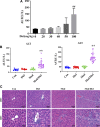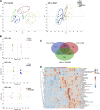Screening for Susceptibility-Related Biomarkers of Diclofenac-Induced Liver Injury in Rats Using Metabolomics
- PMID: 34630079
- PMCID: PMC8494976
- DOI: 10.3389/fphar.2021.693928
Screening for Susceptibility-Related Biomarkers of Diclofenac-Induced Liver Injury in Rats Using Metabolomics
Abstract
Early identification of individuals susceptible to idiosyncratic drug-induced liver injury (IDILI) is a challenging unmet demand. Diclofenac, one of the most widely available over-the-counter drugs for pain management worldwide, may induce liver dysfunction, acute liver failure, and death. Herein, we report that diclofenac-related hepatobiliary adverse reactions occurred more frequently in cases with immune activation. Furthermore, experiments with rats demonstrated divergent hepatotoxicity responses in individuals exposed to diclofenac, and modest inflammation potentiated diclofenac-induced liver injury. Susceptible rats had unique plasma metabolomic characteristics, and as such, the metabolomic approach could be used to distinguish susceptible individuals. The 23 identified susceptibility-related metabolites were enriched by several metabolic pathways related to acute-phase reactions of immunocytes and inflammatory responses, including sphingolipid, tyrosine, phenylalanine, tryptophan, and lipid metabolism pathways. This finding implies a mechanistic role of metabolic and immune disturbances affects susceptibility to diclofenac-IDILI. Further nine metabolite biomarkers with potent diagnostic capabilities were identified using receiver operating characteristic curves. These findings elucidated the potential utility of metabolomic biomarkers to identify individuals susceptible to drug hepatotoxicity and the underlying mechanism of metabolic and immune disturbances occurring in IDILI.
Keywords: biomarker; diclofenac; idiosyncratic drug-induced liver injury; metabolomics; susceptible individual.
Copyright © 2021 Tu, Gao, Song, Niu, Ma, Zhou, He, Xiao and Wang.
Conflict of interest statement
The authors declare that the research was conducted in the absence of any commercial or financial relationships that could be construed as a potential conflict of interest.
Figures





Similar articles
-
Susceptibility-Related Factor and Biomarkers of Dietary Supplement Polygonum multiflorum-Induced Liver Injury in Rats.Front Pharmacol. 2019 Apr 5;10:335. doi: 10.3389/fphar.2019.00335. eCollection 2019. Front Pharmacol. 2019. PMID: 31024306 Free PMC article.
-
Screening for Susceptibility-Related Factors and Biomarkers of Xianling Gubao Capsule-Induced Liver Injury.Front Pharmacol. 2020 May 29;11:810. doi: 10.3389/fphar.2020.00810. eCollection 2020. Front Pharmacol. 2020. PMID: 32547402 Free PMC article.
-
Risk profiling using metabolomic characteristics for susceptible individuals of drug-induced liver injury caused by Polygonum multiflorum.Arch Toxicol. 2020 Jan;94(1):245-256. doi: 10.1007/s00204-019-02595-3. Epub 2019 Oct 19. Arch Toxicol. 2020. PMID: 31630224
-
Diclofenac-induced liver injury: a paradigm of idiosyncratic drug toxicity.Toxicol Appl Pharmacol. 2003 Nov 1;192(3):307-22. doi: 10.1016/s0041-008x(03)00368-5. Toxicol Appl Pharmacol. 2003. PMID: 14575648 Review.
-
Idiosyncratic Drug-Induced Liver Injury: Mechanistic and Clinical Challenges.Int J Mol Sci. 2021 Mar 14;22(6):2954. doi: 10.3390/ijms22062954. Int J Mol Sci. 2021. PMID: 33799477 Free PMC article. Review.
Cited by
-
Morin Attenuates Diclofenac-Induced Hepatocellular Death Injury via Nrf2/Ho-1/NQO1, Beclin-1/LC3A/LC3B and p53/Bax/Caspase Signalling Pathways.J Biochem Mol Toxicol. 2025 Jul;39(7):e70372. doi: 10.1002/jbt.70372. J Biochem Mol Toxicol. 2025. PMID: 40551516 Free PMC article.
-
Investigation of Gynura segetum root extract (GSrE) induced hepatotoxicity based on metabolomic signatures and microbial community profiling in rats.Front Microbiol. 2022 Aug 9;13:947757. doi: 10.3389/fmicb.2022.947757. eCollection 2022. Front Microbiol. 2022. PMID: 36016788 Free PMC article.
-
Diagnostic biomarker panels of osteoarthritis: UPLC-QToF/MS-based serum metabolic profiling.PeerJ. 2023 Jan 13;11:e14563. doi: 10.7717/peerj.14563. eCollection 2023. PeerJ. 2023. PMID: 36655043 Free PMC article.
References
LinkOut - more resources
Full Text Sources

